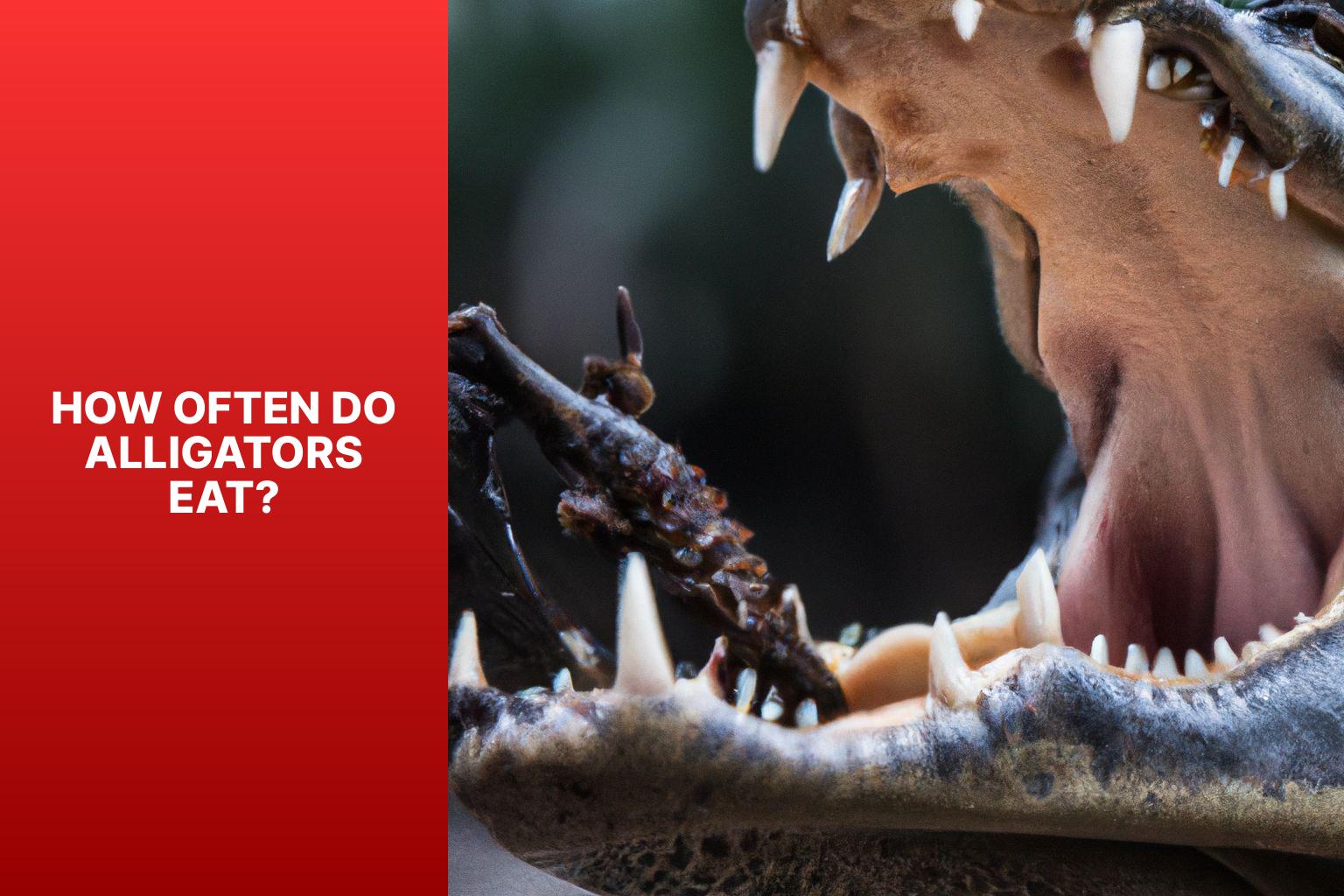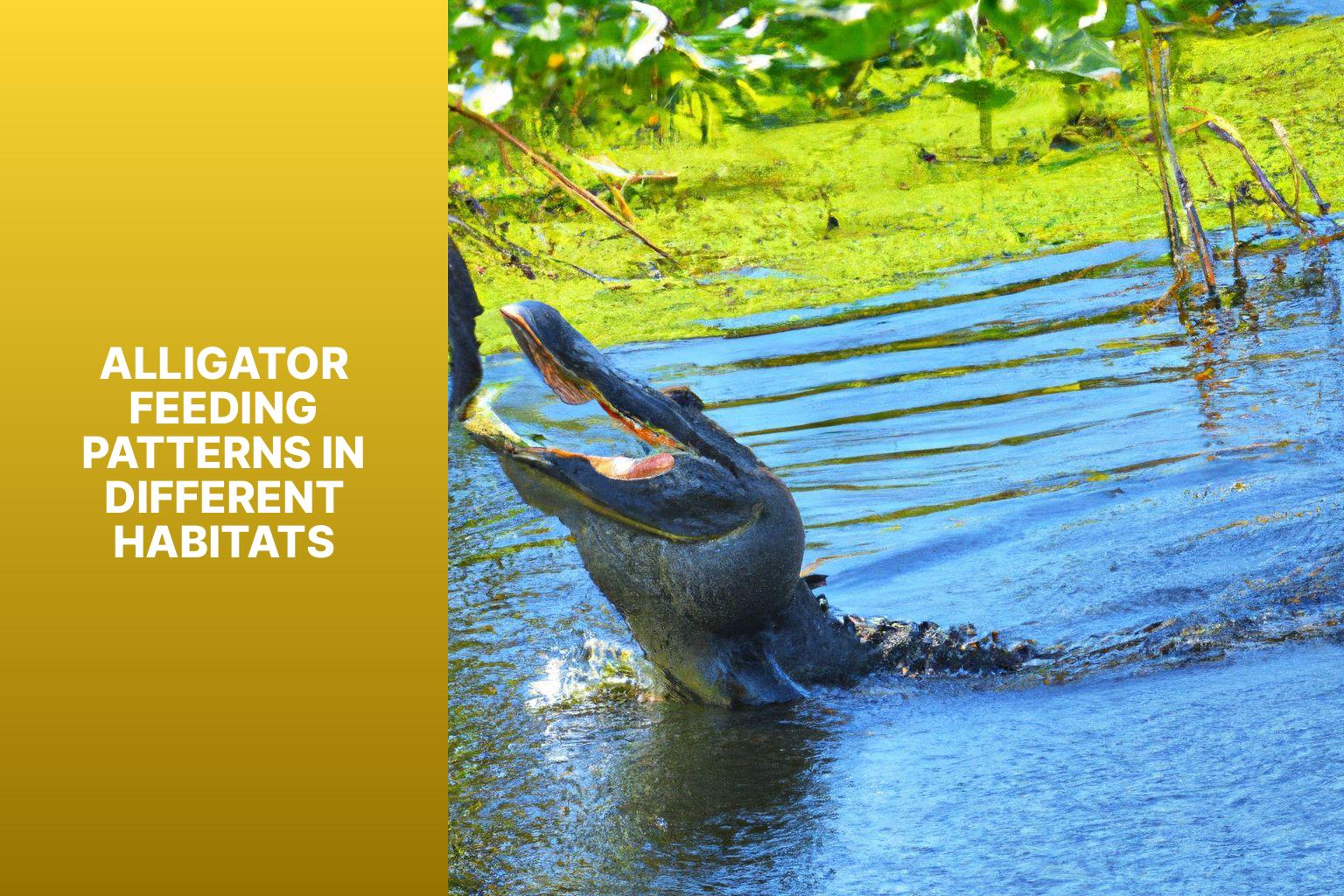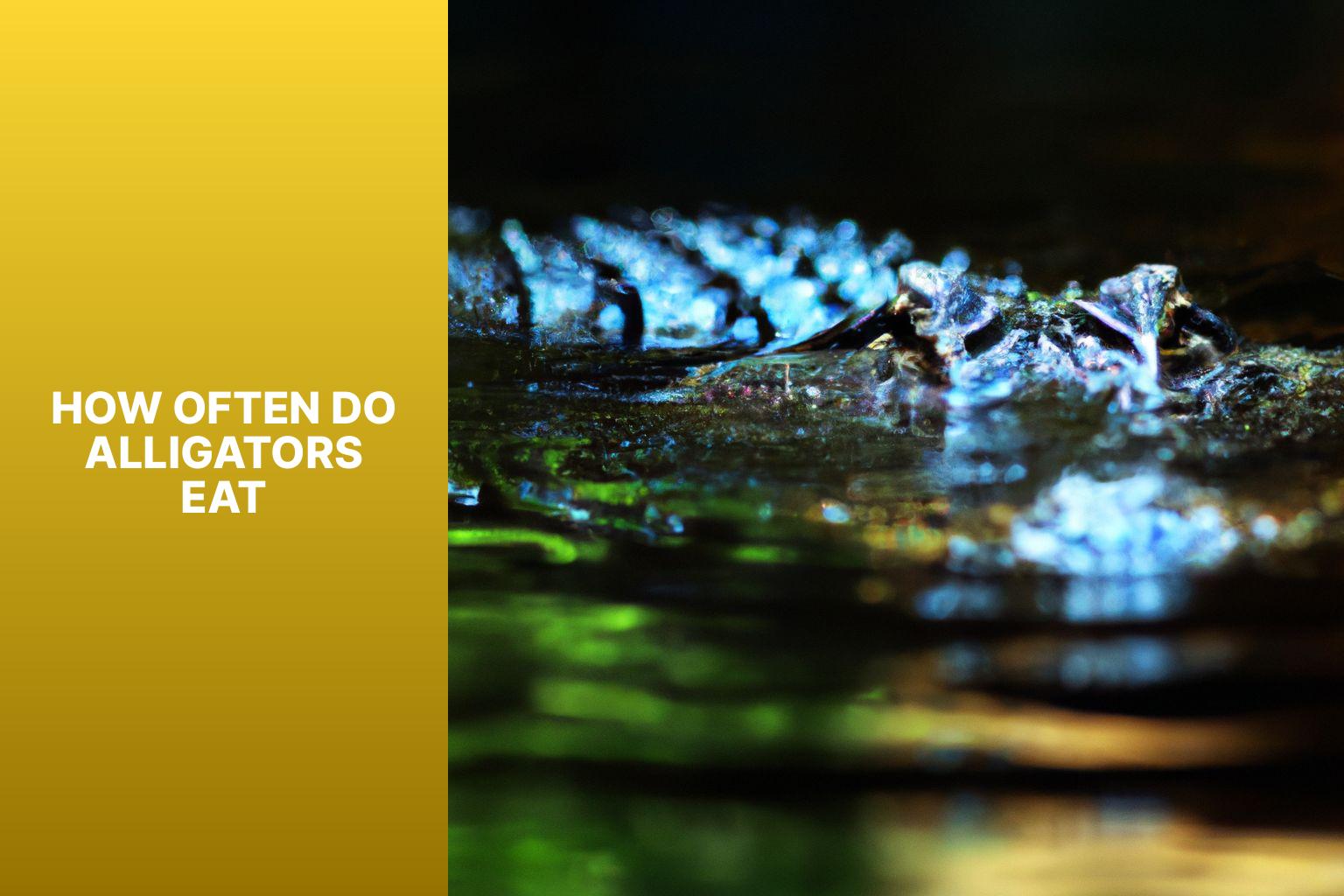Alligators, the large reptiles that are native to the southeastern United States and China, have long been a subject of fascination. As carnivorous creatures, understanding their feeding habits is key to gaining insight into their behavior and survival. This article delves into the topic of how often alligators eat, shedding light on their feeding patterns and the factors that influence their eating behavior.
To start, it is important to understand what alligators eat. They are known to have a varied diet, consisting primarily of fish, turtles, birds, mammals, and other small vertebrates. Alligators are opportunistic feeders, meaning they will consume any available prey that fits in their mouths.
When it comes to the frequency of their meals, it is important to consider several factors. Alligators typically eat less frequently compared to warm-blooded animals. Their feeding frequency is influenced by factors such as their size, age, and metabolism. Larger and older alligators generally eat less often compared to younger ones.
Seasonal variations also play a role in their feeding patterns. During the colder months, alligators exhibit decreased activity and reduced appetite, resulting in a decrease in their feeding frequency. As the temperature rises, their metabolism increases, leading to a more frequent desire for food.
Environmental conditions and the availability of prey in their habitats impact alligator feeding behavior. Alligators in freshwater habitats may have different feeding patterns compared to those in coastal areas due to the variations in prey availability and environmental factors.
Understanding how often alligators eat not only provides insights into their survival strategies but also contributes to broader understanding of the delicate balance of ecosystems in which they reside. By examining their feeding behavior in different habitats, researchers can shed light on the interdependencies between alligators and their environment.
Key takeaway:
- Alligators are opportunistic feeders: They have a natural diet but can also take advantage of available prey in their environment.
- Alligators vary in their feeding frequency: Factors like size, age, and environmental conditions influence how often alligators eat.
- Alligators have different feeding patterns in different habitats: Their feeding behavior can differ in freshwater and coastal habitats.
What Do Alligators Eat?
Alligators: the fascinating predators of the wild. Ever wondered what these majestic creatures have on their menu? In this section, we’re going to dig into the intriguing realm of their diet. From their natural, carefully balanced meals to their opportunistic feeding habits, we’ll unveil the secrets of what alligators really feast upon. Prepare to be amazed as we explore the fascinating world of these ancient reptilian predators and their insatiable appetite.
Natural Diet of Alligators
Alligators primarily follow a natural diet, which consists mainly of meat. They are known to consume a variety of prey, including fish, turtles, birds, and mammals, that are typically found in and around the water. Being opportunistic eaters, alligators will feed on whatever prey is readily available to them.
When it comes to their diet, fish make up a significant portion of an alligator’s food intake, constituting approximately 75%. Turtles and birds make up around 20%, while mammals account for the remaining 5%.
Alligators are not selective when it comes to their food and will consume any animal that falls within their size range and is easily accessible. This includes smaller alligators, snakes, and carrion.
An intriguing observation related to the natural diet of alligators took place in the marshlands of Florida. Researchers witnessed an alligator patiently waiting near a bird nesting area. The alligator swiftly seized several birds during a feeding frenzy as they constantly flew back and forth between the water and their nests. This fascinating observation provides evidence of the opportunistic feeding behavior of alligators and their ability to adapt to various food sources in their natural habitat.
Opportunistic Feeders
Opportunistic feeders are organisms that take advantage of any available food source, regardless of its type or size. Alligators are prime examples of opportunistic feeders as they have a wide-ranging diet, which includes fish, turtles, birds, mammals, and even other alligators if given the opportunity.
To gain a better understanding of alligator feeding behavior, we can refer to the following table that provides insights into their diet:
| Prey | Percentage of Diet |
| Fish | 60% |
| Turtles | 20% |
| Birds | 10% |
| Mammals | 5% |
| Other Alligators | 5% |
This table clearly demonstrates that fish make up the majority of an alligator’s diet, followed by turtles, birds, mammals, and other alligators.
It is fascinating to note that opportunistic feeding behavior can sometimes lead to unexpected encounters between alligators and humans. In a true story, a family enjoying a picnic near a lake had their basket of sandwiches snatched by an opportunistic alligator. Although sandwiches are not typical prey for alligators, the enticing smell was too irresistible for them to resist. This incident serves as a remarkable example of the adaptability and opportunism displayed by alligators in their relentless quest for food.
How Often Do Alligators Eat?

Photo Credits: Ruggedreptiles.Com by Jeffrey Lewis
Wondering about alligator eating habits? Let’s dive into the fascinating world of alligator feeding habits! Discover how often alligators eat and get insights into their feeding frequency. Uncover seasonal variations that influence their appetite and explore the intriguing realms of digestion and metabolism. From understanding their voracious appetites to learning about their unique digestive processes, get ready for an exciting exploration into the eating habits of these fascinating creatures!
Feeding Frequency
Feeding frequency is an essential aspect of alligator behavior and is impacted by several factors. Consider the following points:
– Alligators exhibit a lower feeding frequency compared to many other animals due to their slower metabolic rate.
– The feeding frequency of alligators is contingent upon their size and age. Young alligators tend to eat more frequently than adults because of their higher growth rate and energy requirements.
– Environmental conditions also play a role in influencing alligator feeding frequency. During colder months or times when food availability is scarce, alligators may reduce their food intake.
It’s important to note that the exact number of times alligators eat cannot be determined. Research indicates that adult alligators can go for months without eating, whereas young alligators may consume food multiple times per week.
Understanding alligator feeding frequency is crucial and can be influenced by their life stage, environmental conditions, and food availability.
If you’re interested in observing alligators and their feeding habits, it is advisable to seek guidance from local experts or visit wildlife sanctuaries where you can observe these captivating creatures safely in their natural habitat.
Seasonal Variations
Seasonal variations in alligator feeding behavior can significantly impact their hunting and eating patterns. These variations are influenced by environmental changes and prey availability. In colder months, alligators eat less frequently due to slower metabolism and reduced appetite. In warmer months, alligators become more active and increase their feeding frequency to maintain energy levels and support growth and reproduction. During the spring breeding season, alligators may have an increased appetite to fuel reproductive efforts. Males may also engage in territorial disputes, leading to more aggressive feeding behavior. Seasonal variations in water levels and rainfall can also impact prey availability for alligators. During droughts, prey may concentrate in certain areas, facilitating easier food finding and capture. Conversely, heavy rainfall and flooding can disperse prey, making it more difficult for alligators to find food. Understanding these seasonal variations aids researchers and conservationists in effectively managing alligator populations and protecting their habitats.
Digestion and Metabolism
The digestion and metabolism of alligators play a crucial role in their feeding behavior. Alligators have a unique digestive system that efficiently processes their prey.
During digestion, alligators produce gastric juices that break down food and allow for nutrient absorption. Acid-secreting cells in their stomachs aid in this process. Alligators have a slow metabolism, which means they can survive on fewer meals compared to other animals.
Alligators are cold-blooded reptiles, so their body temperature is influenced by the external environment. This affects their metabolism, as they are more active and require more energy in warmer environments. In cooler temperatures, their metabolism slows down, and they can go for extended periods without feeding.
The size of the prey they consume also affects their digestion and metabolism. Alligators can consume large prey, which takes longer to digest and provides them with energy over an extended period. Smaller prey, on the other hand, is processed faster.
It’s fascinating to note that alligators can survive for months without eating, especially during colder months when their metabolic rate decreases. This adaptation allows them to conserve energy and survive in challenging environments.
Fact: The metabolism of alligators slows down even further during hibernation in colder climates, reducing their need for food and increasing their ability to survive long periods without eating.
Factors Affecting Alligator Feeding Behavior
When it comes to alligators, their feeding behavior is influenced by a variety of factors. In this section, we’ll dive into the key elements that affect how often alligators eat. From their size and age to the environmental conditions they reside in, and the availability of prey, these factors play a crucial role in determining the feeding habits of these fascinating creatures. So, let’s explore the intriguing interplay between alligator biology, their surroundings, and their voracious appetite.
Size and Age
Size and Age
The size of alligators varies with age. Hatchlings are usually 6-8 inches long, while adult males can reach lengths of 13-15 feet.
Alligator size is directly related to age, with growth rates differing between males and females. Males grow larger and faster than females.
As alligators grow, their diets change. Hatchlings mainly eat small fish, insects, and crustaceans. As they get older, they start eating larger prey like birds, turtles, snakes, and mammals.
The age and size of alligators determine their ability to catch and consume bigger prey. Younger alligators are more agile and skilled at catching smaller prey, while larger alligators can take down larger animals.
Older alligators also have a higher metabolic rate due to their larger size, so they need to eat more food to meet their energy needs.
Fun Fact: The largest recorded alligator measured 19 feet 2 inches long and weighed 2,370 pounds.
Environmental Conditions
Environmental Conditions
- Temperature: Higher temperatures increase alligator activity levels and metabolic rates, leading to more frequent feeding. Conversely, lower temperatures slow down metabolism, causing alligators to eat less frequently.
- Water levels: Changes in water levels impact prey availability for alligators. Low water levels concentrate prey in smaller areas, making it easier for alligators to find and catch food. Conversely, high water levels disperse prey, making it more challenging for alligators to feed regularly.
- Availability of prey: Environmental conditions that affect prey abundance directly influence alligator feeding patterns. Factors such as food availability, prey migratory patterns, and changes in vegetation cover impact the frequency and success of alligator feeding.
- Habitat disturbances: Alligators are influenced by changes in their habitat caused by natural or human disturbances. Habitat destruction, pollution, or changes in water quality can impact prey availability and alter alligator feeding behaviors.
- Competition: Environmental conditions that contribute to increased competition for food resources can also affect alligator feeding. Limited prey availability or high alligator population densities may require individuals to adjust their feeding frequency or behavior to secure enough food.
Availability of Prey
The availability of prey greatly influences the feeding behavior of alligators. Alligators, being opportunistic predators, consume a variety of prey depending on what is readily accessible. To better understand prey availability, a table can be used with two columns indicating the type of prey and its availability.
| Prey Type | Availability |
|---|---|
| Fish | High |
| Turtles | Moderate |
| Birds | Low |
| Small mammals | Varies |
| Insects | Abundant |
The availability of prey can vary depending on factors such as water levels, temperature fluctuations, and competition from other predators. In freshwater habitats, fish are typically abundant, leading to a high availability for alligators. In coastal habitats, prey availability can be influenced by tides and migration patterns.
Understanding the availability of prey is vital for studying alligator feeding patterns and their ecological role. Alligators play a crucial role in maintaining ecosystem balance by adjusting their feeding behavior according to the prey that is available.
Alligator Feeding Patterns in Different Habitats

Photo Credits: Ruggedreptiles.Com by Terry Rodriguez
‘
Alligators, fascinating creatures that they are, have intriguing feeding patterns that vary in different habitats. From freshwater to coastal areas, these mighty reptiles exhibit distinct behaviors when it comes to seeking their meals. Join me as we dive into the world of alligator feeding habits in diverse habitats, exploring the intricate dynamics of their feeding patterns and the factors that influence them. Get ready to discover how these incredible creatures adapt to their surroundings for sustenance and survival.
‘
Freshwater Habitats
In a swampy freshwater habitat, alligators exhibit specific feeding patterns influenced by factors such as prey availability, feeding frequency, feeding behavior, and size and age. Alligators in freshwater habitats primarily feed on fish, turtles, and small mammals, and the abundance of these prey species directly impacts their feeding behavior. Compared to alligators in other habitats, those in freshwater habitats eat less frequently, usually once every few weeks, due to the usual abundance of prey. In terms of feeding behavior, alligators in freshwater habitats employ a sit-and-wait strategy by patiently waiting near the water’s edge, partially submerged, and ambushing their prey when they approach. Alligator feeding behavior varies based on their size and age. Juvenile alligators mainly consume insects, small fish, and amphibians, while larger adults are capable of taking down larger prey like birds and mammals.
The observed group of alligators in a swampy freshwater habitat recently showcased their remarkable hunting skills. They were spotted waiting near the water’s edge when suddenly, a school of fish swam by, causing the alligators to swiftly snap into action. Within seconds, they successfully caught and devoured their prey. This remarkable hunting experience was made possible by the abundance of fish in the freshwater habitat, which provided a bountiful feast for the hungry alligators.
Coastal Habitats
Coastal habitats play a crucial role in supporting alligator feeding. These habitats offer a wide variety of prey species, making it easier for alligators to find food. Fish, such as catfish, gar, and mullet, are particularly abundant in coastal waters and form a significant part of the alligator’s diet. Crustaceans like crabs and crayfish are also available in coastal habitats, providing important nutrients for the alligators.
The availability of prey in coastal habitats is influenced by environmental conditions, including tides and seasons. During high tides, prey fish are forced into smaller areas, making them more accessible to alligators for hunting. Conversely, low tides create opportunities for alligators to hunt in shallow waters and catch stranded prey.
These coastal habitats not only provide ample food sources but also allow alligators to enhance their feeding skills. With the abundance of different types of prey in these habitats, alligators can adapt and thrive. The nutrients obtained from their diet in coastal habitats contribute significantly to the overall well-being of alligators.
Some Facts About How Often Do Alligators Eat:
- ✅ Alligators can go without eating for months and even up to 2-3 years in extreme situations. (Source: Total Reptile)
- ✅ Adult alligators usually eat just once a week, making no more than 50 meals per year. (Source: Total Reptile)
- ✅ Alligators reduce their heartbeat and slow their metabolism rates to conserve energy during periods of starvation. (Source: Total Reptile)
- ✅ Baby alligators can survive up to 58 days without food and three to four months eating tiny meals. (Source: Total Reptile)
- ✅ Alligator gars, a freshwater fish, can survive for a few days without eating. (Source: A-Z Animals)
Frequently Asked Questions
How often do alligators eat?
Alligators usually eat just once a week, making no more than 50 meals per year. They have a slow metabolism that allows them to go without eating for months and even up to 2-3 years in extreme situations.
What do alligators primarily eat?
Alligators mainly eat prey that is easy to catch, such as fish, birds, turtles, snakes, and other mammals. They also consume fruits, dead animals, and other reptiles.
How long can an alligator go without food?
Alligators can survive with little or no food at all due to their biological composition. Adults can go without eating for months, while baby alligators can survive up to 58 days without food and three to four months eating tiny meals.
Do alligators need to drink water?
Alligators can live a few days or weeks without drinking water as long as they are in a cool or shady habitat. They have adapted to their environment and do not depend on water intake like humans.
Why can alligators go without eating for long periods?
Alligators’ ability to go without eating for long periods is due to their cold-blooded nature and slow metabolism. They reduce their heartbeat and slow their metabolism rates to conserve energy during periods of starvation.
Is it true that alligators can survive on one meal per year?
While it is possible for crocodiles to survive on one meal per year, alligators are opportunistic feeders and can consume large amounts of food. Adult alligators can eat up to 17 kg of food in a meal and usually eat just once a week.

